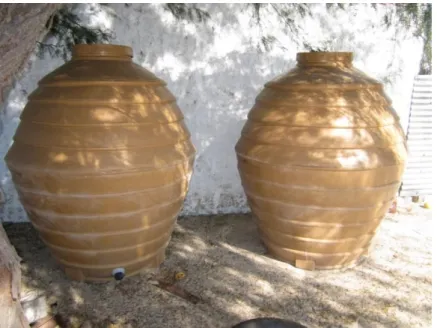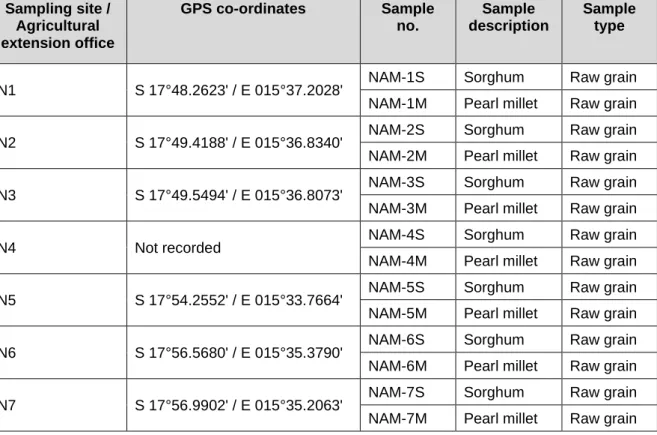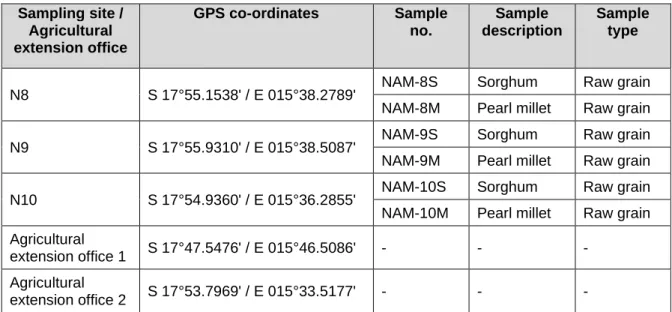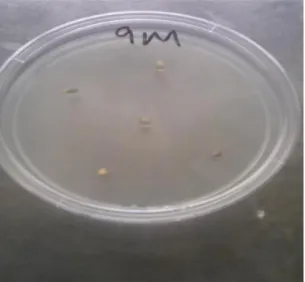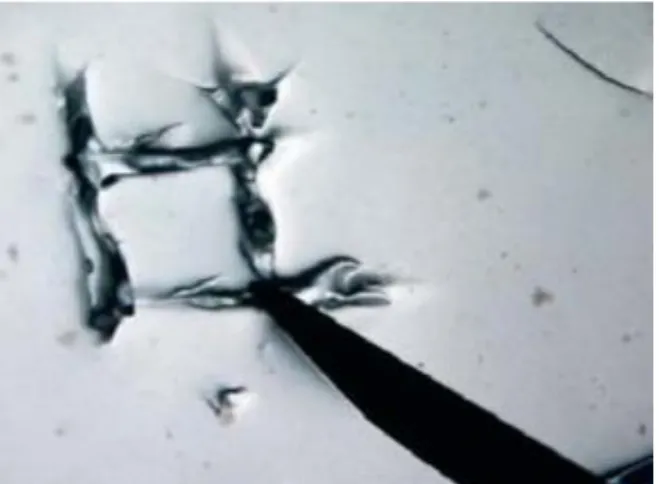Smallholder communities in northern Namibia are heavily dependent on sorghum and pearl millet as staple foods. The study provided important information on the degree of fungal and multiple mycotoxin contamination of raw and processed sorghum and pearl millet in the Oshana region of northern Namibia.

Introduction
The study provides important information on the degree of mycotoxigenic fungal and multiple mycotoxin contamination of unprocessed sorghum and pearl millet, as well as the transfer of fungi and mycotoxins to processed products sold in local markets. Ultimately, the study will make an important contribution to food safety and security in Namibia.
Statement of research problem
The present study involved mycological and multiple mycotoxin surveillance of raw sorghum (Sorghum bicolor) and pearl millet (Pennisetum glaucum) produced on small farms and processed products sold in open markets in the Oshana region of northern Namibia. The project will potentially have a significant impact on Namibia's agricultural industry through the development of sound production and processing practices.
Research questions
Objectives of the research
Ethical clearance
Delineation of research
Significance of the research: social and economic impact
Expected outcomes, results and contributions of the research
Sorghum (Sorghum bicolor) and pearl millet (Pennisetum glaucum): important staple crops in southern Africa
Mycotoxigenic fungal species and mycotoxins in staple grains .1 Aspergillus spp
Fusarium spp
Trichothecenes are phytotoxic compounds and act as virulence factors for susceptible plant hosts (Boutigny et al., 2012). This mycotoxin is heat stable and does not denature during processing and cooking (Atoui et al., 2011).
Mycotoxins and their effect on human health
Methods to determine the magnitude of fungal contamination in grains
Techniques for quantification of multiple mycotoxins in grains
This technique is highly sensitive, can detect low concentrations of multiple mycotoxins in one run and offers a high degree of precision and accuracy (Pascale et al., 2019). However, the technique requires extensive validation of the extraction and analysis techniques to ensure the accuracy and precision of the results (Bessaire et al., 2019).
Contamination of sorghum and millet with mycotoxigenic fungi and mycotoxins The most important sorghum stalk rot and grain mould diseases on sorghum is caused by
This type of analysis requires sophisticated technology and experience which is only available at the main mycotoxin testing laboratories in South Africa ie. in Namibia, the diversity of fungal metabolites was determined in ingredients from street-sold pearl millet and sorghum and their transfer rate during fermentation to Oshikundu, a traditional Namibian beverage (Misihairabgwi et al., 2018).
Effect of climatic conditions on mycotoxin production
Studies on the relative expression of mycotoxin biosynthetic genes confirmed these findings (Medina et al., 2015). Extreme weather conditions (temperature, CO2 and rainfall) lead to plant stress and a higher prevalence of mycotoxins (Milićević et al., 2019).
Mycotoxin regulations
Mycotoxin contamination of staple crops in southern Africa
Postharvest systems of smallholder farmers in northern Namibia
Some storage baskets used in the north central region of Namibia are made from the leaves of the Makalawi palm. Due to the lack of trees in the Oshana region, some farmers have resorted to using plastic storage containers, which are available in the market (Figure 2.3).
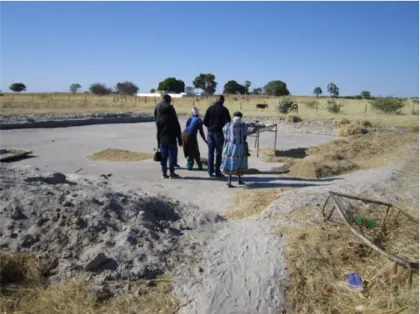
Control strategies for reducing mycotoxins in grains
Technological control methods .1 Biocontrol microorganisms
- Plant extracts
- Resistance breeding and genetic modification
- Adsorbents
It is based on mechanisms such as competition for nutrients and space, parasitism of the pathogen and antagonism (Alberts et al., 2017). Butylhydroxyanisole (BHA) and propylparaben (PP) are antioxidants produced by organisms such as the algae Botryococcus braunii and Cylindrospermopsis raciborskii (BHA) and plants such as carrots and olives (PP) (Etcheverry et al., 2002; Reynoso et al., 2002).
Community-based methods
- Diet diversification and practical methods
- Creating awareness
The negative effects of mycotoxins in food can be reduced by incorporating clay adsorbents during food processing. Fumonisins and aflatoxins can be tightly and selectively bound by the phyllosilicate clay montmorillonite, rendering them biologically inactive and non-toxic in the gastrointestinal tract of experimental animals (Alberts et al., 2017).
Conclusions
Status of Fusarium mycotoxins in sub-Saharan Africa: A review of emerging trends and postharvest mitigation strategies for food control. Occurrence of Fusarium species and mycotoxins in Nepalese maize and wheat and the effect of traditional processing methods on mycotoxin levels. Effectiveness of regulatory limits for fumonisin mycotoxins in commercial maize crops and maize crops in South Africa.
Quantification of mycotoxins in food and feed from Burkina Faso and Mozambique using a modern LC-MS/MS multitoxin method.
Introduction
Co-occurrence of fumonisins and aflatoxins has been reported in sorghum and pearl millet from smallholder farmers under the management of the International Institute for Tropical Agriculture, Nigeria (Vismer et al., 2019). Conventionally, toxic fungal species are identified using morphology and cross-fertility techniques (Leslie et al., 2001; Sampietro et al., 2010). These approaches are often highly dependent on the analyst's skills (Faria et al., 2012).
When grown on this medium, aflatoxigenic fungal strains typically fluoresce blue under UV light (Rodríguez-Lázaro et al., 2013).
Materials and Methods
Collection of sorghum and pearl millet samples
There was a high degree of similarity in isozyme patterns between the isolates of the same group, regardless of geographic origin, suggesting that isolates within a given group are descendants of the same ancestral population. Wide variation in isozyme patterns between specific groups of isolates suggested that they were of distinctly different origins (Láday et al., 2000). Due to similarities between closely related species (e.g., A. parasiticus and A. nomius), morphological identification is not easy (Rodrigues et al., 2007; Marasas et al., 2001).
The aim of this study was to determine the prevalence of the most important mycotoxic fungal species in raw sorghum and pearl millet (Pennisetum glaucum) samples collected from small farmers and processed samples obtained from open markets in the Oshana region of northern Namibia.
Isolation and enumeration of mycotoxigenic fungal species from raw whole grain samples
- Isolation of Fusarium spp
- Preparation of pure cultures by preparing Fusarium spp. single spores
- Isolation of Aspergillus spp
Sampling locations and description of raw grain samples collected in the Oshakati sampling area. A dissecting microscope was used to examine the germinated spores (Figure 3.4) and a scalpel blade used to transfer it to a fresh potato dextrose agar (PDA) plate (Figure 3.5), where after incubation at 25°C and 30°C. A compound microscope and a dissecting microscope were both used in morphological identification and single spore isolation.
The presence of the unique yellow-orange pigment visible on the bottom of the agar plates was used to indicate the presence of A.
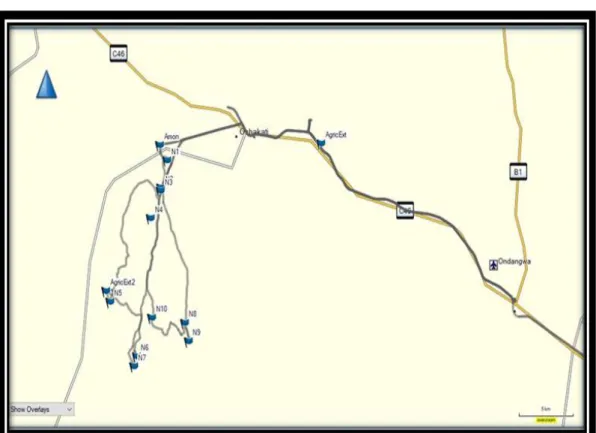
Isolation and enumeration of mycotoxigenic fungal species from processed samples
Statistical analysis
Results
Isolation and enumeration of mycotoxigenic fungal species from raw whole grain samples
- Isolation and incidence of Fusarium and Aspergillus spp
Isolation and enumeration of mycotoxigenic fungal species from processed samples
Discussion
NAM-12S and NAM-19M were obtained from Oshakati market, while NAM-24S and NAM-27S were obtained from Ondangwa market. NAM-11S, NAM-18M and NAM-19M were obtained from Oshakati market, while NAM-25S was obtained from Ondangwa market. High levels of fungal contamination in raw and processed samples can be attributed to agricultural practices and pre- and post-harvest processing (Alberts et al., 2017).
Mycotoxin awareness campaigns and education on the subject will go a long way in reducing mycotoxin contamination during sorghum and pearl millet processing.

New PCR assays for the identification of Fusarium verticillioides, Fusarium subglutinans and other species of the Gibberella fujikuroi complex. Identity of Fusarium nygamai isolates with long and short microconidial chains from millet, sorghum and soil in Africa. Mycotoxin contamination of sorghum and its contribution to human dietary exposure in four sub-Saharan countries.
Molecular identification, mycotoxin production and comparative pathogenicity of Fusarium temperatum isolated from maize in China.
Introduction
Conventional PCR mimics in vitro the natural DNA replication capacity on a large scale (Valones et al., 2009). This method requires identification of the DNA target, which is used to develop primers that hybridize specifically to the target sequence (Valones et al., 2009). SYBR Green 1 binds non-specifically to the duplexes of DNA generated during amplification (Valones et al., 2009).
Microbial diagnosis and management of food spoilage organisms are two main areas of food microbiology (Klancnik et al., 2012).
Materials and Methods
- Sorghum and pearl millet samples
- Extraction of DNA from sorghum and pearl millet
- Extraction of DNA from pure fungal cultures
- Conventional PCR
- Quantitative Real-time PCR (qPCR)
- Optimization and preparation of standard curves
- Quantification of Fusarium and Aspergillus spp. in sorghum and pearl millet samples using qPCR
A qPCR method using species-specific primers adopted from Nicolaisen et al (2009) was successfully used to quantify the abundance of F. A DNeasy Plant Mini Kit (Qiagen Cat. no. 69104) was used to extract gDNA according to a procedure adapted from Boutigny et al. Both procedures were adopted from Sardinas et al. 2010) and the reactions performed using a T100 Thermal Cycler PCR (Bio-Rad, California, USA).
The Fusarium species-specific primers used in this experiment were adapted from Nicolaisen et al.

Results
- The quality and concentration of gDNA extracted from sorghum, pearl millet and fungal cultures
- Optimization of the qPCR conditions
- Optimization of Aspergillus species-specific qPCR identification
- Optimization of Fusarium species-specific qPCR identification
- Quantitative Real-time PCR
Sample NAM-27 was contaminated with all three Fusarium spp., while 15% of samples showed co-contamination of two Fusarium spp., with F. 44% of contaminated sorghum samples originated from Ondangwa market and 56% from Oshakati the market. Sample NAM-17 was infected with all four Fusarium spp., while NAM-23 contained three Fusarium spp.
All the contaminated samples were processed grains and market bought with 36% and 64% of the contaminated samples originating from Ondangwa and Oshakati markets respectively.
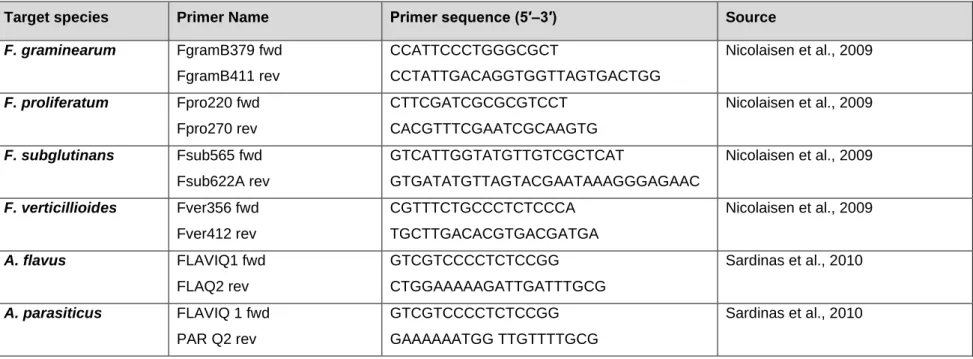
Discussion
High-quality DNA was extracted from sorghum and pearl millet samples, as well as reference liquid cultures of Fusarium and Aspergillus spp. The slope of the standard curves and the amplification efficiency achieved were within acceptable limits. In this study, the use of species-specific primers allowed the detection and quantification of Fusarium spp.
It is important to determine when contamination with mycotoxigenic fungi occurs and if it is associated with the appearance of the related mycotoxins to help understand the fungal life cycle and curb the fungal infection and the subsequent mycotoxin contamination (García-Díaz et al., 2020).
Conclusion
More research needs to be done on the fungal, host and environmental interactions as various factors influencing pathogenicity, virulence and mycotoxin production. However, this method is not completely reliable because the absence of a certain mycotoxin fungus does not guarantee the absence of mycotoxins. A follow-up study can be done to determine if there is a correlation between the amount of fungal target DNA (qPCR) and the grain quality.
Quantification of Fusarium graminearum and Fusarium culmorum by real-time PCR system and estimation of zearalenone in maize. Identification of filamentous fungal isolates by MALDI-TOF mass spectrometry: Clinical evaluation of an expanded library of reference spectra. PCR method for detection of Fusarium genus and fumonisin-producing isolates from freshly harvested sorghum grains grown in Karnataka, India.
Application of time-of-flight matrix-assisted laser desorption ionization mass spectrometry for the identification of molds of the genus Fusarium.
Introduction
Co-occurrence of AF and FB has been reported in sorghum and pearl millet from smallholder farmers under the management of the International Institute for Tropical Agriculture in Nigeria (Vismer et al., 2015). Various techniques are used for the detection and quantification of mycotoxins in cereals, including enzyme-linked immunosorbent assay (ELISA), high performance liquid chromatography (HPLC) and liquid chromatography with tandem mass spectrometry (LC-MS/MS) (Agriopoulou et al. , 2020). The method is tedious and requires a skilled analyst, but gives accurate results (Agriopoulou et al., 2020).
LC-MS/MS analyzes are currently used worldwide to quantify multiple mycotoxins in grains (Pascale et al., 2019).
Materials and Methods .1 Chemicals
- Sorghum and pearl millet samples
- Analytical standards
- Multi-mycotoxin analyses
- Extraction method
- LC-MS/MS analyses
- Validation of the extraction and chromatographic methods
- Correlation between Fusarium spp. occurrence and mycotoxin levels
- Statistical analyses
LC-MS/MS analyzes of the samples were performed in conjunction with the Mass Spectrometry Unit of the Central Analytical Facility, Stellenbosch University. Precision was determined by rescreening samples with known amounts of individual mycotoxins to determine precision. The relationship between instrument response and known analyte concentrations is shown by a calibration curve.
After LC-MS/MS analyses, peak areas (LC-.MS response factors) were plotted as a function of analyte concentrations (µg/kg).
Results and discussion
The results of the analytical validation experiments on sorghum and pearl millet are summarized in Tables 5.2 and 5.3, respectively. No mycotoxins were detected in any of the raw sorghum and pearl millet samples collected from 10 smallholder farmers' families in Oshakati (Table 5.4). In the present study, 20 and 54% of processed sorghum and pearl millet samples, respectively, contained AFB1 (3–14 µg/kg).
Co-occurrence of FB1, FB2, FB3 and ZEA was detected in both sorghum and pearl millet.
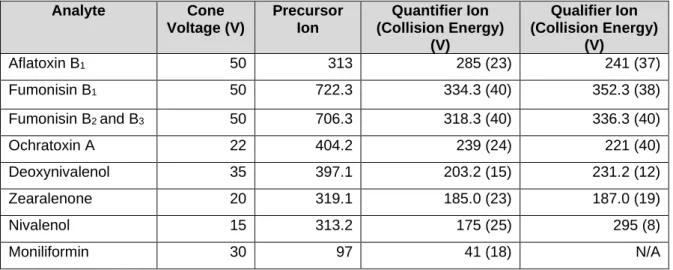
Rural subsistence maize farming in South Africa: Risk assessment and intervention models for reducing exposure to fumonisin mycotoxins. Potential of sorghum and finger millet to improve household food security in Zimbabwe's semi-arid regions: A review. Bacteria, Yeasts and Molds in Malting and Brewing: Proceedings of the Xth Symposium, Leuven (Belgium), 15-18 September 2002.
I Enhancing Nutritional and Functional Properties for Africa Proceedings of a Workshop on the Proteins of Sorghum and Hirse, 2.-4. april 2003, Pretoria, Sydafrika.



